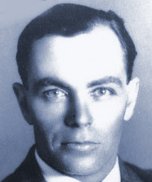Herbert J.L. Hinkler
Today, we meet an odd almost-hero of early aviation. The University of Houston's College of Engineering presents this series about the machines that make our civilization run, and the people whose ingenuity created them.
 Bert Hinkler was Australia's first pioneer of aviation. Born in 1892 in the East-Coast town of Bundaberg, he fixated on flying right from the start. When he was 14 he tried to make an ornithopter -- an airplane whose wings flap. It failed, but in 1911 he did make quite a successful glider. A year later, the first itinerant barnstormer -- a man named Wizard Stone -- showed up in Australia. Hinkler fastened on to him like a barnacle.
Bert Hinkler was Australia's first pioneer of aviation. Born in 1892 in the East-Coast town of Bundaberg, he fixated on flying right from the start. When he was 14 he tried to make an ornithopter -- an airplane whose wings flap. It failed, but in 1911 he did make quite a successful glider. A year later, the first itinerant barnstormer -- a man named Wizard Stone -- showed up in Australia. Hinkler fastened on to him like a barnacle.
In 1914 Hinkler went to England to work in the Sopwith company. And during WW-I he flew bombers, but he had little stomach for the work of bombing and strafing retreating troops. Still, he brought back medals and a new wife -- a nurse he'd met in France.
After the war, he turned to long-distance flying. He was only five-foot-three, and that gave him a real edge in a cramped cockpit. He dreamt of flying back home to Australia. He first tried to make the flight in 1920, but he had to turn back at Rome. It seems war had broken out around his fuel stop in Syria.
He set his first official record on a flight from England to Latvia, and he finally made his flight to Australia in 1928. It wasn't the first, but he did set a record flying the leg from Darwin to his home in Bundaberg nonstop. And there he enjoyed his greatest moment of glory -- parades, speeches, and a popular song that began, Hustling Hinkler, up in the sky ...
In 1928 he went to America, where he'd taken up with another woman some years before. He tried to set up his own airplane company, but the depression squashed any chance of success and drove him back to England. A year later he married his American friend and moved her to Paris.
Then, of course, the noose of his double marriage began closing in on him. But Hinkler kept moving. He took off in an attempt to beat the earlier England-Australia flight records, and then he vanished into thin air over Italy's Apennine mountains. Three months later, a charcoal gatherer found his crashed plane with his frozen body nearby. The investigation showed that he'd thrown a propeller blade. It also suggested sabotage.
The plot thickens when we find that his home was rifled a week before the flight. Documents were stolen, and all the pictures of his mother were smashed. Was there a conspiracy here? Did it involve a wife or an angry colleague? We're left to wonder.
The strange story of Bert Hinkler leaves us unsatisfied, but in it we surely see the sort of raw, driving compulsion that brought flight into being. Hinkler didn't do so well with the parts of his life outside the hangar and the cockpit. But there he clearly was one of the many driven geniuses who helped shape the reality of flight out of the stuff of dreams.
I'm John Lienhard, at the University of Houston, where we're interested in the way inventive minds work.
(Theme music)
For more on Hinkler see the following website: https://en.wikipedia.org/wiki/Bert_Hinkler
We recommend that you go to the updated and revised version of this program, Episode 1561.